Where to Eat the Best Indian Food in London Right Now
Yes, there are more places than just Dishoom for modern Indian cuisine.
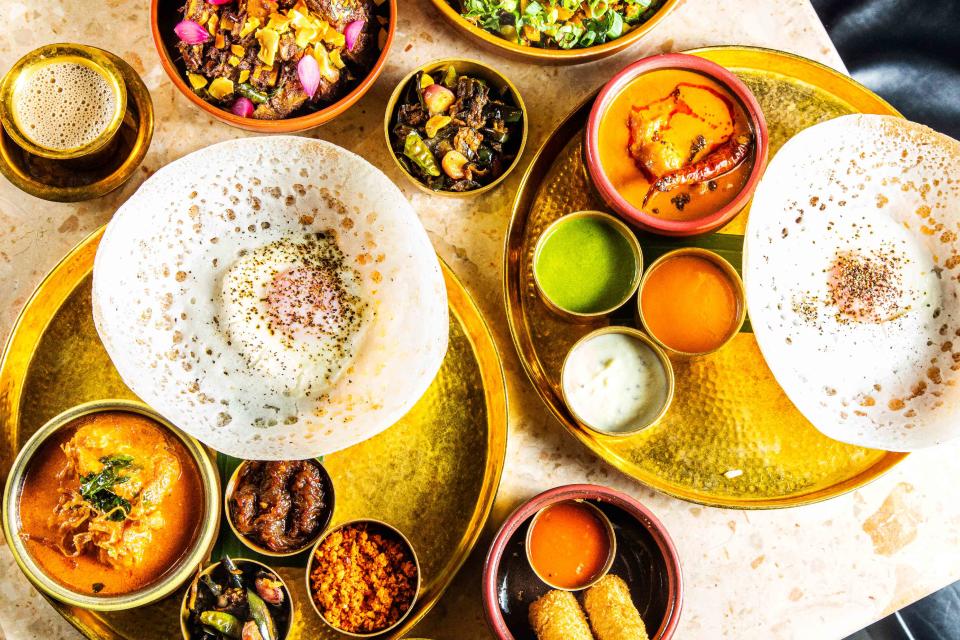
David Loftus
A selection of hoppers, sambols, and chut- neys from Hoppers, which specializes in southern Indian and Sri Lankan cuisineOn a temperate Saturday night in London, I followed the host down the stairs to the packed communal table at Kricket’s Soho location, one of three in the city, to meet a friend. A playlist of Bollywood bangers and certified hits from the early aughts bounced around the restaurant, opened in 2015 by Will Bowlby and Rik Campbell, as the plates started to touch down at the table: super craggy and crunchy Keralan fried chicken topped with perfect circles of pickled radish and crispy curry leaves, a sweet-and-salty kulcha stuffed with dates and pistachios that easily could have passed for a more glutenous baklava, a comforting khichdi made with hunks of smoked haddock and a burst of corn kernels, and a thick slab of paneer swimming in a pool of creamy, tomato-spiked malai sauce. The robust menu drew inspiration from all over India: The fried chicken was from the south, the paneer from the north; the khichdi blended the flavors of several states. Other dishes found their origins in the coastal state of Goa or the street-food traditions of Mumbai.
It was a welcome and surprising departure from the food that Indian restaurants in central London have historically served. Though no one wants to admit it, for several decades the options were, quite frankly, a little boring. Diners were stuck choosing between the endless platters of chicken tikka masala and stacks of onion bhaji at their local British curry house, or the fussy plating, ridiculously opulent decor, and extravagant prices at the upscale “contemporary” Indian restaurants that dotted posh neighborhoods like Mayfair and Chelsea. Indian restaurants have been around in London since the Hindoostane Coffee House opened in 1810. The city’s first Indian fine-dining restaurant, Veeraswamy, opened in 1926 (and remains open today), but modernity has been slow to come. Most restaurants have focused on either Anglo-Indian fare or specialties coming out of northern India, like tandoori chicken, samosas, and naan.
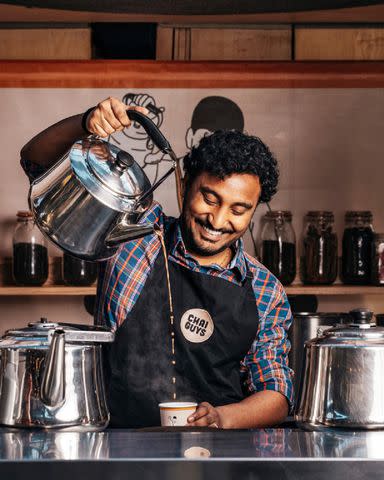
Haydon Perrior
Haridev Chitturi, a staff member at the Spitalfields location of Chai Guys, demonstrates the art of pouring chai from a height, which cools down and froths the teaThen in 2010, a restaurant by the name of Dishoom opened its doors in Covent Garden. Inspired by the Irani cafés of Mumbai, Dishoom embraced a much more casual atmosphere, lower prices, and a menu that was a departure from curry house classics, offering creative fare like a now-iconic bacon naan roll at breakfast and gunpowder potatoes and chile cheese toast at dinner. The restaurant, opened by cousins Shamil and Kavi Thakrar, managed to become even more famous for the hours-long queue. The success of Dishoom gave others permission to build establishments that were more approachable, ushering in a new wave of Indian restaurants in central London that celebrate regional Indian cooking — and are not afraid to have a strong point of view.
Related: A Lesson in Live-Fire Cooking from the Legendary Madhur Jaffrey
Like Kricket, many of the new generation of Indian restaurants explore pan-Indian cooking, borrowing inspiration, flavors, and techniques from all over the country. This approach is also embraced at Gunpowder, opened in 2015 by Harneet and Devina Baweja. Here, Goan grilled prawns come out of the kitchen after the pulled duck from Chettinad that is served with uttapam, a crispy rice-and-lentil pancake from the southern Indian states, and a side of hard-boiled eggs cooked in a spiced tomato sauce that is a staple in northern Indian cooking. (The restaurant now has three locations: in Spitalfields, Tower Bridge, and Soho.)
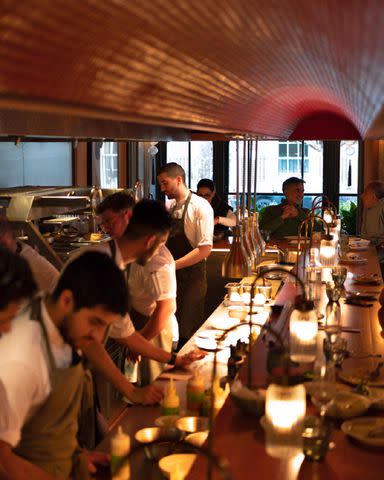
Sam Cornish
BiBiâs open-air kitchenAt Pahli Hill, which opened in 2020 in Fitzrovia, chef Avinash Shashidhara casually jumps from khakhra, a crunchy flatbread that is popular in the western state of Gujarat, to paper-thin dosas and sambar from the south, to crisp fried squid that draws its influence from Puducherry, a former French colony. The Tamil Prince, a new pub in a quiet, residential corner of Islington that opened in 2022, exhibits the same ease, serving puffy, deep-fried bread known as bhatura and channa, a spiced chickpea dish, both beloved in northern India, alongside Thanjavur chicken curry, cooked down with tomato, curry leaves, and spices, a dish from the southern state of Tamil Nadu. It’s also worth stopping in at Jikoni, which chef Ravinder Bhogal opened in Marylebone in 2016. It’s one of the few female-owned Indian restaurants in London, and Bhogal pulls her inspiration not just from regional Indian cooking but also the African diaspora, serving a cup of Kenyan-style chai with dishes like paan madeleines, the buttery cookies infused with the flavor of the post-meal betel-leaf treat.
The new crop of Indian restaurants also leans heavily into the cooking from a single region of India or its diasporas. One of the most delightful examples is Fatt Pundit, opened in 2019, which specializes in Indo-Chinese food — a cuisine that blends Indian flavors with Chinese ingredients and cooking techniques that are rooted in Kolkata. Here, momos arrive to the table steaming, stuffed with tender minced chicken and lots of alliums, or with a satisfying blend of spinach, mushrooms, zucchini, and tofu. They’re best followed with an order of soft-shell crab cooked with lots of sweet corn and Szechuan peppercorn, and a platter of Hakka chile lettuce cups that cradle a sweet-salty-spicy filling of diced paneer sautéed with lots of shallot and soy sauce.
Hoppers, which opened its first location in 2015, has found much success slinging southern Indian and Sri Lankan staples like the namesake hoppers (savory baskets made of rice flour and coconut milk), snacks like murukku (spirals of deep-fried gram flour), and a whole range of dosas, including one topped with chiles and melty cheese. Chourangi, which opened in Marylebone in 2021, is dedicated to exploring the flavors of Kolkata in a beautiful and streamlined dining room. The restaurant does not hold back, serving plates of pickled hilsa, a small herring-like fish that is a staple of Bengali home cooking, and bowls of kosha mangsho, a Bengali lamb dish cooked with fragrant whole spices. Bengali staples also show up on the menu at chef Asma Khan’s Darjeeling Express, originally open from 2017 to 2020, reopened in February 2023. Here, Khan is determined to give regional Indian cooking the spotlight it deserves through dishes like coconutty, creamy prawn malaikari and bhapa doi, a steamed yogurt dessert that is almost like cheesecake.
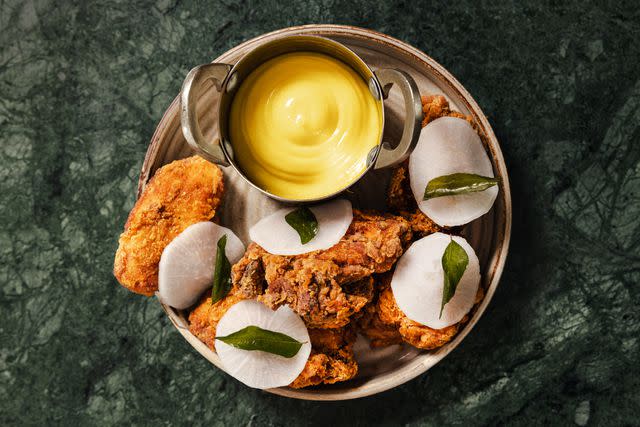
Rebecca Hope
Keralan fried chicken with curry leaf mayonnaise and pickled radish at KricketIf there’s one thing that unites the chefs behind all of these restaurants, it’s that they are determined to redefine what Anglo-Indian cooking looks like, moving it away from its colonial roots and centering local ingredients and playful takes on classic British dishes. Khan proudly uses British beets in several dishes on her menu. BiBi, which opened in Mayfair in 2021, describes itself as having “contemporary Indian flavor, exceptional British produce.” The restaurant works with farmers across the U.K. for its produce, meat, and seafood, highlighting scallops from Devon, Swaledale lamb in its barra kebab, and local rhubarb in the kanji, a soothing rice porridge. Even the charcoal the restaurant uses to grill the meat is sustainably sourced from the coast. At Pahli Hill, produce like violet artichokes and proteins like Hampshire ribs and Scottish langoustines are sprinkled throughout the menu.
Related: Meet the Chef Who Changed Indian Food in America Forever
It doesn’t look like this movement is slowing down anytime soon, with new concepts continuing to open as brick-and-mortars and pop-ups. Take chef Farokh Talati’s side concept showcasing Parsi home cooking. In addition to cooking at St. John Bread and Wine, Talati hopes to eventually open a restaurant dedicated to Parsi food in the middle of London. This new wave has yet to crest.
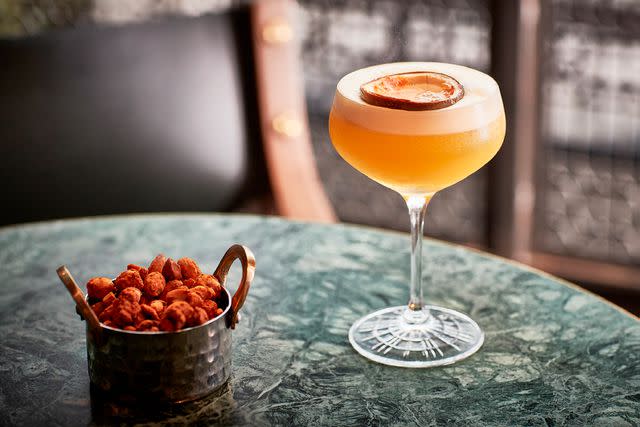
Rebecca Hope
The Junoon cocktail at Soma, which incorporates Indian flavors into its drinks programWhere to drink
Bandra Bhai
Walk down the set of stairs and past the cheeky artwork on the walls of Pahli Hill, and you’ll enter Bandra Bhai, the restaurant’s sister cocktail bar that advertises itself as a “delightfully tacky” ode to the 1970s Indian smugglers’ den. The couches are velvet, the art is gaudy, and the drinks are just as over-the-top, with names like Disco Inferno and Gold Fashioned, made with ingredients like smoked jaggery, saffron, and Alphonso mangoes.
Soma
Next door to Kricket in Soho is this sleek cocktail bar dedicated to reimagining classic drinks with Indian flavors. Soma is a Vedic Sanskrit word that means “to distill and extract,” and that is the ethos of the bar. Cocktails include a daiquiri made with banana skin, discarded-banana-peel rum, and Aphrodite bitters, and a margarita crafted with chaat masala.
Chai Guys
Dedicated to the art of masala chai and masala chai only, Chai Guys has two locations: inside Seven Dials Market in Covent Garden and Old Spitalfields Market on the east side. Staff will theatrically pour fresh cups from large kettles. The shop offers four versions, with varying degrees of spices and milk — I’m partial to the classic, made with lots of black pepper, ginger, and cloves.
Where to stay
Nobu Hotel Portman Square
Conveniently located within walking distance of a few of the restaurants on this list, Nobu is a great place to rest between meals. The rooms are outfitted with plush beds, Nespresso machines, and Grown Alchemist bath products and include comfy yukata robes for lounging, plus a gorgeous traditional Japanese tea set for maximum relaxation. Rooms from $575
One Aldwych Covent Garden
Renovated in 2019, the rooms at One Aldwych feel like mini luxury apartments with lots of modern touches, like plenty of well-placed outlets and Google Chromecast. The hotel is bursting with amenities, including a full spa, a lap pool, and a private library for guests. But the best amenity of all is the complimentary minibar brimming with great snacks and high-quality drinks, including a few alcoholic options. Rooms from $1,079
The Hoxton, Shoreditch
The Shoreditch location of this modern hotel chain is an affordable option in close proximity to the Tube and several great Indian restaurants. The hotel has nine concept rooms designed by local artists and will leave breakfast in a bag hanging on your door each morning (should you for some reason decide to forgo the nearby Dishoom for your first meal of the day). The Hoxton group also has a location in Shepherd’s Bush, with a restaurant from Los Angeles–based chef and 2016 F&W Best New Chef Kris Yenbamroong. Rooms from $300
For more Food & Wine news, make sure to sign up for our newsletter!
Read the original article on Food & Wine.

